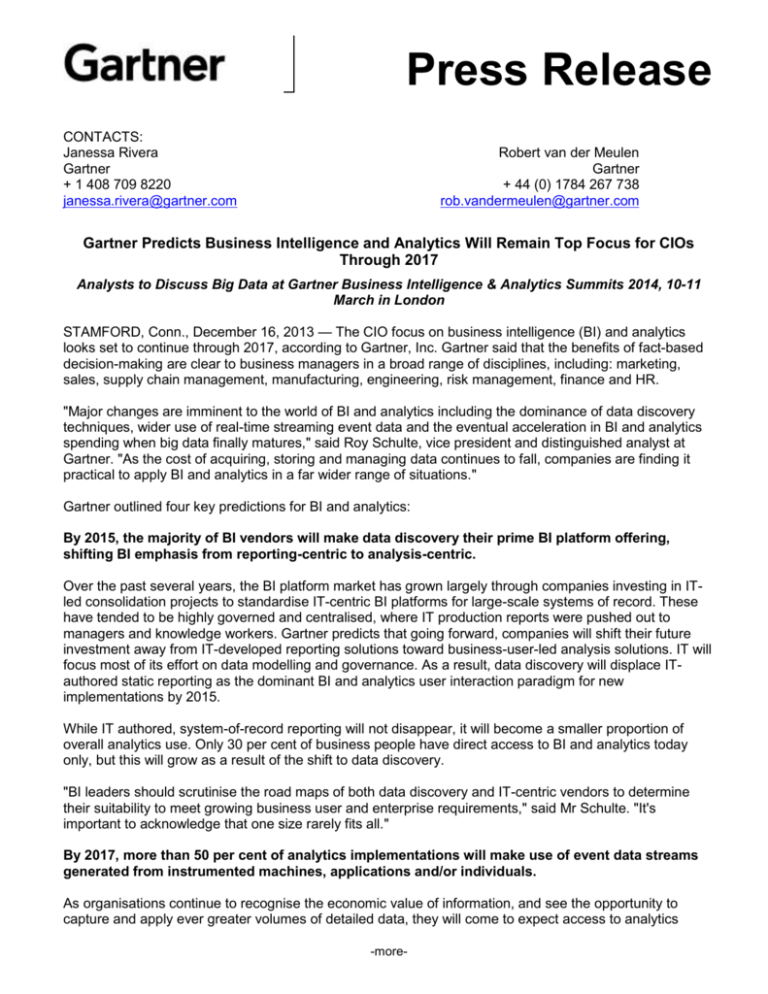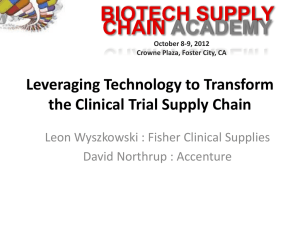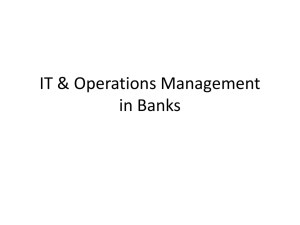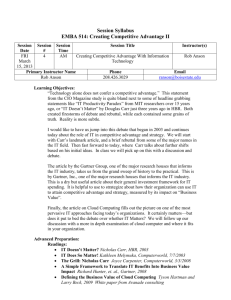19990729 - KPC
advertisement

Press Release CONTACTS: Janessa Rivera Gartner + 1 408 709 8220 janessa.rivera@gartner.com Robert van der Meulen Gartner + 44 (0) 1784 267 738 rob.vandermeulen@gartner.com Gartner Predicts Business Intelligence and Analytics Will Remain Top Focus for CIOs Through 2017 Analysts to Discuss Big Data at Gartner Business Intelligence & Analytics Summits 2014, 10-11 March in London STAMFORD, Conn., December 16, 2013 — The CIO focus on business intelligence (BI) and analytics looks set to continue through 2017, according to Gartner, Inc. Gartner said that the benefits of fact-based decision-making are clear to business managers in a broad range of disciplines, including: marketing, sales, supply chain management, manufacturing, engineering, risk management, finance and HR. "Major changes are imminent to the world of BI and analytics including the dominance of data discovery techniques, wider use of real-time streaming event data and the eventual acceleration in BI and analytics spending when big data finally matures," said Roy Schulte, vice president and distinguished analyst at Gartner. "As the cost of acquiring, storing and managing data continues to fall, companies are finding it practical to apply BI and analytics in a far wider range of situations." Gartner outlined four key predictions for BI and analytics: By 2015, the majority of BI vendors will make data discovery their prime BI platform offering, shifting BI emphasis from reporting-centric to analysis-centric. Over the past several years, the BI platform market has grown largely through companies investing in ITled consolidation projects to standardise IT-centric BI platforms for large-scale systems of record. These have tended to be highly governed and centralised, where IT production reports were pushed out to managers and knowledge workers. Gartner predicts that going forward, companies will shift their future investment away from IT-developed reporting solutions toward business-user-led analysis solutions. IT will focus most of its effort on data modelling and governance. As a result, data discovery will displace ITauthored static reporting as the dominant BI and analytics user interaction paradigm for new implementations by 2015. While IT authored, system-of-record reporting will not disappear, it will become a smaller proportion of overall analytics use. Only 30 per cent of business people have direct access to BI and analytics today only, but this will grow as a result of the shift to data discovery. "BI leaders should scrutinise the road maps of both data discovery and IT-centric vendors to determine their suitability to meet growing business user and enterprise requirements," said Mr Schulte. "It's important to acknowledge that one size rarely fits all." By 2017, more than 50 per cent of analytics implementations will make use of event data streams generated from instrumented machines, applications and/or individuals. As organisations continue to recognise the economic value of information, and see the opportunity to capture and apply ever greater volumes of detailed data, they will come to expect access to analytics -more- technologies capable of making sense from event streams. This goes beyond traditional and mainstream BI to a breed of technologies capable of producing autonomous insights and inferences quickly. To produce and harvest this data from physical assets and other event sources, the market will expand for flexible, multipurpose sensors for temperature, humidity, vibration, pressure, sound, light/colour, electrical or other utility flows, motion, facial expressions, voice inflection, health monitoring and other systems. Moreover, such event data from physical assets (operational technology [OT]) is sometimes combined with event data from administrative information systems (information technology [IT]) to develop richer, more powerful holistic systems (creating an IT/OT convergence). In addition, technology and consumer product vendors are hastening to enable their wares to capture and emit more consumption and environmental data. Several SaaS application vendors in particular, have already intensified their ability to collect more usage data and are devising quid-pro-quo arrangements with customers that allow leveraging their deidentified data for alternate commercial purposes. "Nontech businesses leaders should create an inventory of the range of current data collected by their products and services, then consider what additional high-value information could be captured through further instrumentation," said Mr Schulte. "Application and other technology managers should ensure that the data collected from IT systems, applications, devices and users is maximised with equal consideration for performance implications and probable future business relevance." By 2017, analytic applications offered by software vendors will be indistinguishable from analytic applications offered by service providers. Traditional vendors of analytic platforms recognise that in order to expand their reach beyond traditional power users, they must deliver packaged domain expertise and applications to enable self-service by a wider range of users. Service providers are seeking to turn custom project work and domain expertise into repeatable solutions that can be adopted by other organisations more easily. The result is that end-user organisations selecting analytic applications will have a significantly wider variety of possible providers to evaluate. Organisations evaluating software vendors will almost always find a SaaS version of their packaged applications, and the similarity of product concepts will shift the emphasis of competition to the domain expertise embedded by the vendors into the application. Software vendors will increasingly face a co-opetition situation with their traditional service provider channels, forcing them to augment their own professional service capabilities. Service providers will use packaged applications as an integral part of their customer relationships, implying that there is a greater specialisation in the services that they provide. Until 2016, big data confusion will constrain spending on BI and analytics software to single-digit growth. Despite the strong interest in BI and analytics, confusion around big data is inhibiting spending on BI and analytics software. Until 2016, service providers will garner business by closing the gap between available big data technology and business cases. As big data matures and more packaged intellectual property is available, big data analytics will become more relevant, mainstream and, ultimately, hugely disruptive. Recent Gartner surveys show that only 30 per cent of organisations have invested in big data, of which only a quarter (eight per cent of the total) have made it into production. This leaves room for substantial future growth. Analytics plays squarely into the big data trend, where the growing volume, velocity and variety of data create opportunities outside of the traditional, established BI domains and buying centres. However, that also makes the sourcing of analytics bigger and more technically complex than what has been done before. Gartner, Inc. page 2 Paradoxically, the confusion that surrounds the "big data" term and the uncertainty about the tangible benefits of big data are partially to blame for the soft BI and analytics market. Procurement cycles have slowed while budget holders try to match the right tooling to the right business case. In the interim, BI and analytics continue to remain at the forefront for CIOs, and service providers will attempt to bridge much of the confusion. The gap will completely close when those services will become "productised." This, in addition to a confluence of technology maturity cycles, is expected to occur around 2016. Beyond 2016, when the solution has found the problem, when the discussion has matured from technology to business, and when there will be more off-the-shelf capability available, big data analytics will pervade almost everything that we do, helping push society unequivocally into the digital age. More detailed analysis is available in the report "Predicts 2014: Business Intelligence and Analytics Will Remain CIO's Top Technology Priority." The report is available on Gartner's web site at http://www.gartner.com/document/2629220?ref=QuickSearch&sthkw=schulte%20AND%20BI%20AND%2 0%22predicts%22. Additional information and analysis on BI, analytics and information management will be discussed at the Gartner Business Intelligence & Analytics Summits 2014 taking place 10-11 March in London. Further details can be found at http://www.gartner.com/technology/summits/emea/business-intelligence/. Members of the press can register for this Summit by contacting Rob van der Meulen at rob.vandermeulen@gartner.com. Information from the Gartner BI Summits 2014 will be shared on Twitter at http://twitter.com/Gartner_inc using #GartnerBI. About Gartner Gartner, Inc. (NYSE: IT) is the world's leading information technology research and advisory company. Gartner delivers the technology-related insight necessary for its clients to make the right decisions, every day. From CIOs and senior IT leaders in corporations and government agencies, to business leaders in high-tech and telecom enterprises and professional services firms, to technology investors, Gartner is a valuable partner in more than 13,000 distinct organizations. Through the resources of Gartner Research, Gartner Executive Programs, Gartner Consulting and Gartner Events, Gartner works with every client to research, analyze and interpret the business of IT within the context of their individual role. Founded in 1979, Gartner is headquartered in Stamford, Connecticut, USA, and has 5,800 associates, including more than 1,450 research analysts and consultants, and clients in 85 countries. For more information, visit www.gartner.com. ### Gartner, Inc. page 3







